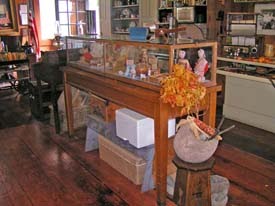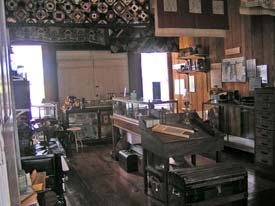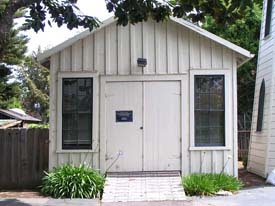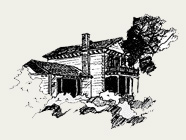The Volck Museum in the Carriage House
 When visiting the Volck Museum in the Carriage House you’ll feel like you’ve stepped back in time. You’ll be surrounded by a treasure trove of antiques and vignettes of every day life in Pajaro Valley in the early 1900s. Step up to the counter in the general store. Imagine what food was being prepared in the cozy kitchen. Write on the chalk board by the student’s seat from the local school house. Admire the piano that entertained everyone in the family before there was TV or computers.
When visiting the Volck Museum in the Carriage House you’ll feel like you’ve stepped back in time. You’ll be surrounded by a treasure trove of antiques and vignettes of every day life in Pajaro Valley in the early 1900s. Step up to the counter in the general store. Imagine what food was being prepared in the cozy kitchen. Write on the chalk board by the student’s seat from the local school house. Admire the piano that entertained everyone in the family before there was TV or computers.
History of the Volck Museum and Carriage House — by Jane Borg
Following the organization of the Pajaro Valley Historical Association in the 1940s, members met in homes or in the old Watsonville City Hall. In the 1950s Helen Volck Tucker donated her home at 261 East Beach Street in Watsonville to be used as a museum. She asked that the house be named the Volck Museum in honor of her first husband, William H. Volck, a University of California trained entomologist who was sent to study the coddling moth devastation that threatened the entire apple industry.
In the 1990s, Zoe Orr Marcus, widow of Frank Orr, longtime editor of the Register-Pajaronian newspaper, donated the Bockius-Orr property at 332 East Beach Street to the association. Eventually the Volck Museum was sold and the association moved to the Bockius-Orr location.
 The Carriage House
The Carriage House
The small carriage house, located behind the Bockius-Orr Historic House, was used to store buggies, wagons and other horse-drawn vehicles. In early times, a barn would have provided shelter for horses and other livestock a greater distance from the house. Today, a barn no longer exists on the property and the carriage house is used for delightful exhibits that bring the history of Pajaro Valley alive. You are invited to visit the Volck Museum in the Carriage House, honoring the wishes of Helen Volck Tucker, the donor of the first museum.
 Built in the early 1870s, a prominent feature of the carriage house is a wide ramp leading up to double doors. Like the main house, the carriage house was elevated about a foot and a half above ground level in order to allow rising floodwaters to run in and out below the floor. A buggy could be easily pulled up into the carriage house via the ramp. After the property was donated to the PVHA, the board of directors agreed to insulate and panel the interior of the building. A heater was installed to maintain temperature control, and the floor was cleaned of many years of grease accumulation.
Built in the early 1870s, a prominent feature of the carriage house is a wide ramp leading up to double doors. Like the main house, the carriage house was elevated about a foot and a half above ground level in order to allow rising floodwaters to run in and out below the floor. A buggy could be easily pulled up into the carriage house via the ramp. After the property was donated to the PVHA, the board of directors agreed to insulate and panel the interior of the building. A heater was installed to maintain temperature control, and the floor was cleaned of many years of grease accumulation.
